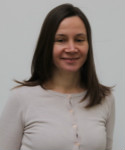
Prof. Jovana Petrovic
Technische Universität Berlin, Germany/Vinca Institute of Nuclear Sciences, University of Belgrade, Serbia
Title: High-density bend-free photonic integrated circuits
Abstract:
We challenge the current thinking and approach to design of photonic
integrated circuits (PICs), which are marked as drivers of the future
information processing.
Standard quantum PICs are composed of the unit cells based on
directional couplers. The couplers typically consist of two waveguides
bent to exhibit coupling in the proximity region. They conveniently
produce the maximally entangled Bell state and have been used to
construct functional optical quantum PICs [1]. However, their full
exploitation faces the conceptual and technical challenges including the
non-intrinsic scalability that requires waveguide branching, the
radiation loss at waveguide bends and the therewith associated
high-density packaging limit [2].
Arrays of linearly coupled parallel waveguides have been considered a
viable alternative. However, the intricate inverse design of the
corresponding Hamiltonians has limited their applications to the
particular instances of the quantum logic gates obtained by numerical
optimization procedures and machine learning [3, 4] and the simulators
of the condensed matter systems, such as spin and Bloch arrays with the
Wannier-Stark ladder spectrum [5]. A generic design solution based on a
common physical and mathematical principle has not been reached.
We propose a new concept for the design of bend-free high-density PICs
composed exclusively of the linearly coupled commensurable waveguide
arrays. Their operation is based on the periodic continuous quantum walk
of photons and leverages on the engineered waveguide coupling. We
discuss the class of analytically accessible designs with the
eigenspectra that randomly sample the Wannier-Stark ladder [6, 7]. The
free choice of eigenfrequencies marks a clear distinction from the
current photonic simulators and provides a variety of novel circuit
layouts and functionalities. In particular, we rework the designs of
interconnects for qubits and qudits, multiport couplers, entanglement
generators and interferometers. The analytical results are corroborated
numerically. Finally, we test the robustness of the proposed building
blocks to the random variations in design parameters, with a view to
defining acceptable fabrication tolerances.
REFERENCES
[1] J. Wang, et al. Science 360, 285 (2018).
[2] W. Song, et al., Nat. Commun. 6, 2027 (2015).
[3] Y. Lahini, et al., npj Quantum Inf. 4, 2 (2018).
[4] A. Youssry, et al., Quant. Sci. Technol. 5, 025001 (2020).
[5] M. Gräfe, A. Szameit, J. Phys. B: Atom. Mol. Opt. Phys. 53,
073001 (2020).
[6] J. Petrovic, J. J. P. Veerman, Ann. Phys. 392, 128 (2018).
[7] J. Petrovic, Opt. Lett. 40, 139 (2015).
Biography:
Dr Jovana Petrovic graduated from the School of Electronic Engineering, University of Belgrade, Serbia and earned her PhD from the Aston Institute of Photonic Technologies, Birmingham, UK. Upon postdoctoral research at the University of Oxford, UK and the Laboratory for Nonlinear Spectroscopy, Florence, Italy, and the tenured appointment at the Vinca Institute, Belgrade, Serbia, she joined the Centre for Free Electron Laser Science, Deutsches Elektronen-Synchrotron DESY, Hamburg, Germany. She is appointed as an Associate Research Professor at the University of Belgrade. Dr. Petrovic has made a number of contributions to photonics, atomic and molecular physics. Her main scientific interests are in the areas of fibre-optic sensing, ultrafast lasers and laser cooling and control of atoms and molecules. Her research has resulted in 45 journal and 80 conference contributions and the foundation of a spin-off company. Dr. Petrovic serves as an expert project evaluator and monitor to the European Commission and is an active member of the Optical Society of America, Optical Society of Serbia and the German Physical Society